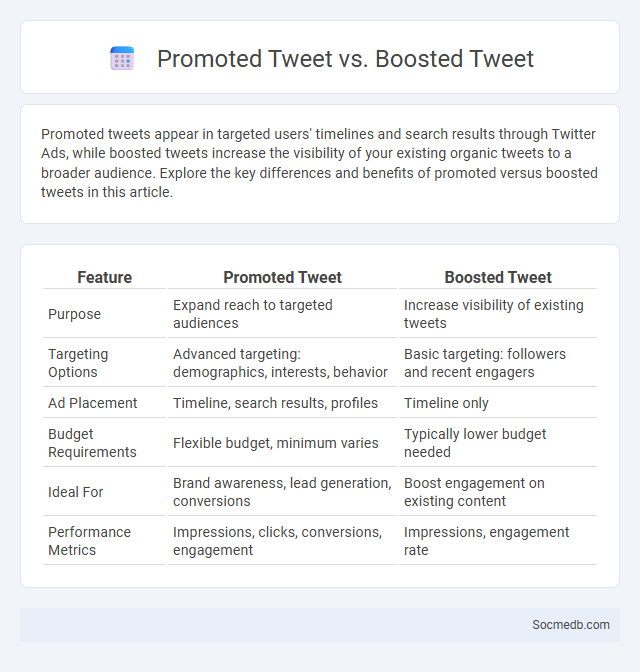
Photo illustration: Promoted tweet vs Boosted tweet
Promoted tweets appear in targeted users' timelines and search results through Twitter Ads, while boosted tweets increase the visibility of your existing organic tweets to a broader audience. Explore the key differences and benefits of promoted versus boosted tweets in this article.
Table of Comparison
| Feature | Promoted Tweet | Boosted Tweet |
|---|---|---|
| Purpose | Expand reach to targeted audiences | Increase visibility of existing tweets |
| Targeting Options | Advanced targeting: demographics, interests, behavior | Basic targeting: followers and recent engagers |
| Ad Placement | Timeline, search results, profiles | Timeline only |
| Budget Requirements | Flexible budget, minimum varies | Typically lower budget needed |
| Ideal For | Brand awareness, lead generation, conversions | Boost engagement on existing content |
| Performance Metrics | Impressions, clicks, conversions, engagement | Impressions, engagement rate |
Promoted Tweets vs Boosted Tweets: Key Differences
Promoted Tweets are paid advertisements appearing in targeted users' timelines, search results, and profiles, designed for precise audience segmentation through advanced targeting options such as keywords, interests, and demographics. Boosted Tweets simply amplify the reach of existing organic tweets by turning them into ads, focusing on enhancing engagement with minimal targeting controls. Understanding these differences helps you optimize your Twitter marketing strategy by choosing the most effective method for your campaign goals and audience.
What Is a Promoted Tweet?
A promoted tweet is a paid advertisement on Twitter designed to increase visibility beyond organic reach, targeting specific audiences based on demographics, interests, and behaviors. These tweets appear in users' timelines, search results, or profiles, blending seamlessly with regular content while driving engagement, website traffic, or conversions. Marketers leverage promoted tweets to boost brand awareness, promote campaigns, and enhance social media marketing strategies effectively.
What Is a Boosted Tweet?
A boosted tweet is a paid advertisement on Twitter designed to increase the reach and engagement of your original tweet by targeting specific audiences based on demographics, interests, and behaviors. This promotional feature enhances visibility beyond your current followers, driving more impressions, clicks, and interactions. You can control your budget, duration, and target criteria to maximize the effectiveness of your boosted tweet campaign.
Objectives of Promoted Tweets
Promoted Tweets aim to increase brand visibility and engagement by targeting specific audiences with relevant content. They drive website traffic, app installs, and conversions through tailored messaging and call-to-action buttons. Measuring success involves tracking impressions, click-through rates, and user interaction metrics to optimize campaign performance.
Goals of Boosted Tweets
Boosted Tweets increase the visibility of your content by targeting specific audiences based on demographics, interests, and behaviors, enhancing engagement and brand awareness. They drive higher click-through rates and conversions by reaching users who are more likely to interact with your message. You can effectively amplify your social media goals by leveraging Boosted Tweets to expand reach and foster meaningful interactions.
Audience Targeting Capabilities
Social media platforms offer advanced audience targeting capabilities that enable advertisers to reach specific demographics based on age, location, interests, and behaviors. Utilizing data analytics and machine learning algorithms, platforms like Facebook, Instagram, and LinkedIn optimize ad delivery to maximize engagement and conversion rates. Precise targeting reduces ad spend wastage and enhances campaign effectiveness by connecting brands with the most relevant users.
Cost and Budget Comparison
Social media advertising budgets vary significantly, with platforms like Facebook and Instagram offering cost-effective options featuring average CPM (cost per thousand impressions) rates between $5 and $12, while LinkedIn ads often command higher CPMs around $25 due to targeting professionals. Small businesses typically allocate 10-25% of their total marketing budget to social media campaigns, prioritizing platforms with the highest ROI. Cost efficiency depends on factors such as audience targeting precision, ad format, and campaign objectives, influencing overall budget allocation and performance metrics.
Analytics and Performance Metrics
Social media analytics involves tracking key performance metrics such as engagement rate, reach, impressions, and click-through rate to measure the effectiveness of content strategies. Platforms like Facebook Insights, Twitter Analytics, and Instagram Insights provide detailed data on audience demographics, behavior patterns, and content interaction, helping marketers optimize campaigns. Understanding conversion rates and sentiment analysis further enhances decision-making, driving improved ROI and targeted audience growth.
When to Use Promoted vs Boosted Tweets
Promoted Tweets are ideal for reaching a specific target audience beyond your followers and measuring campaign performance with advanced analytics, making them perfect for long-term marketing goals. Boosted Tweets increase visibility among your existing followers and their networks, providing quick engagement and immediate response for time-sensitive promotions. Choose Promoted Tweets when You need detailed audience targeting and conversion tracking, while Boosted Tweets work best for enhancing organic reach and driving instant interactions.
Choosing the Best Twitter Promotion Strategy
Selecting the best Twitter promotion strategy requires analyzing your target audience's behavior and engagement patterns on the platform. Focus on creating compelling, shareable content and leveraging Twitter Ads to boost visibility and reach specific demographics. Optimize Your campaign by monitoring key metrics like click-through rates and follower growth to refine ad placements and messaging.
 socmedb.com
socmedb.com